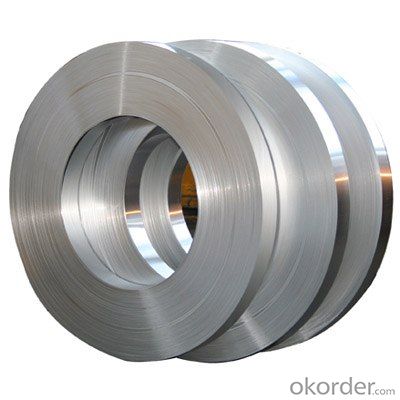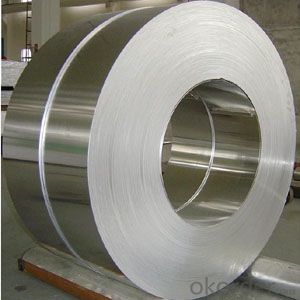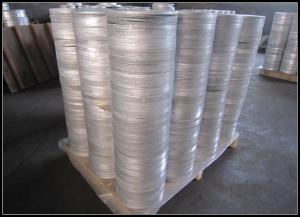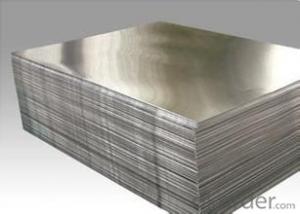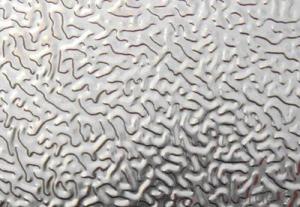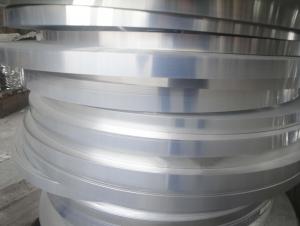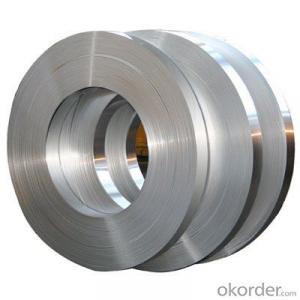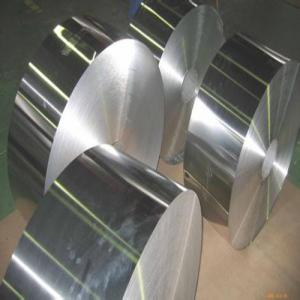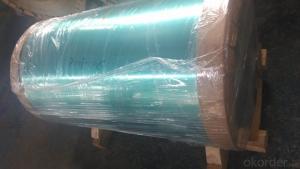Thin Strips of Aluminum - Aluminio Sheet for Someuse
- Loading Port:
- China Main Port
- Payment Terms:
- TT OR LC
- Min Order Qty:
- -
- Supply Capability:
- -
OKorder Service Pledge
OKorder Financial Service
You Might Also Like
Aluminium foil acts as a total barrier to light and oxygen (which cause fats to oxidise or become rancid), odours and flavours, moistness, and germs, it is used broadly in food and pharmaceutical packaging. The purpose of aluminium is to make long-life packs (aseptic processing|aseptic packaging) for drinks and dairy goods, which allows storing without refrigeration. Aluminium foil containers and trays are used to bake pies and to pack takeaway meals, ready snacks and long life pet foods.
Aluminium foil is widely sold into the consumer market, often in rolls of 500 mm (20 in) width and several metres in length.It is used for wrapping food in order to preserve it, for example, when storing leftover food in a refrigerator (where it serves the additional purpose of preventing odour exchange), when taking sandwiches on a journey, or when selling some kinds of take-away or fast food. Tex-Mex restaurants in the United States, for example, typically provide take-away burritos wrapped in aluminium foil.
Aluminium foils thicker than 25 μm (1 mil) are impermeable to oxygen and water. Foils thinner than this become slightly permeable due to minute pinholes caused by the production process.
Aluminium foil has a shiny side and a matte side. The shiny side is produced when the aluminium is rolled during the final pass. It is difficult to produce rollers with a gap fine enough to cope with the foil gauge, therefore, for the final pass, two sheets are rolled at the same time, doubling the thickness of the gauge at entry to the rollers. When the sheets are later separated, the inside surface is dull, and the outside surface is shiny. This difference in the finish has led to the perception that favouring a side has an effect when cooking. While many believe that the different properties keep heat out when wrapped with the shiny finish facing out, and keep heat in with the shiny finish facing inwards, the actual difference is imperceptible without instrumentation.The reflectivity of bright aluminium foil is 88% while dull embossed foil is about 80%.
We provide a full range of precision aluminum strip for almost any application. We produce aluminum strip in a wide variety of alloys, including clad composites. Our aluminum strip can be produced in standard dimensions or custom made to your special requirements. We produce both imperial and metric units. We manufacture in compliance with the main international specifications, and tighter tolerances or custom tempers are available upon request. We offer various surface conditions, custom finishes (painting, anodizing, embossing), special processing, and multiple packaging options to meet our customer's unique requirements. The following is a summary of our capabilities.
Manufactured in compliance with the main international specifications and standards, including: Aluminum Association, ASTM, EN, and DIN.
We can also manufacture in compliance with other international standards including:ASME, SAE, AMS, AWS, FED, MIL, QQ, ISO, BS, AFNOR, JIS and GOST.
Manufactured in compliance with the main international specifications and standards.
Tighter tolerances are available upon request.
Aluminium (or aluminum; see spelling differences) is a chemical element in the boron group with symbol Al and atomic number 13. It is a silvery white, soft, ductile metal. Aluminium is the third most abundant element (after oxygen and silicon), and the most abundant metal in the Earth's crust. It makes up about 8% by weight of the Earth's solid surface. Aluminium metal is so chemically reactive that native specimens are rare and limited to extreme reducing environments. Instead, it is found combined in over 270 different minerals.The chief ore of aluminium is bauxite.
Aluminium is remarkable for the metal's low density and for its ability to resist corrosion due to the phenomenon of passivation. Structural components made from aluminium and its alloys are vital to the aerospace industry and are important in other areas of transportation and structural materials. The most useful compounds of aluminium, at least on a weight basis, are the oxides and sulfates.
Despite its prevalence in the environment, no known form of life uses aluminium salts metabolically. In keeping with its pervasiveness, aluminium is well tolerated by plants and animals. Owing to their prevalence, potential beneficial (or otherwise) biological roles of aluminium compounds are of continuing interest.
The earliest citation given in the Oxford English Dictionary for any word used as a name for this element is alumium, which British chemist and inventor Humphry Davy employed in 1808 for the metal he was trying to isolate electrolytically from the mineral alumina. The citation is from the journal Philosophical Transactions of the Royal Society of London: "Had I been so fortunate as to have obtained more certain evidences on this subject, and to have procured the metallic substances I was in search of, I should have proposed for them the names of silicium, alumium, zirconium, and glucium."
Davy settled on aluminum by the time he published his 1812 book Chemical Philosophy: "This substance appears to contain a peculiar metal, but as yet Aluminum has not been obtained in a perfectly free state, though alloys of it with other metalline substances have been procured sufficiently distinct to indicate the probable nature of alumina."[69] But the same year, an anonymous contributor to the Quarterly Review, a British political-literary journal, in a review of Davy's book, objected to aluminum and proposed the name aluminium, "for so we shall take the liberty of writing the word, in preference to aluminum, which has a less classical sound."
The -ium suffix conformed to the precedent set in other newly discovered elements of the time: potassium, sodium, magnesium, calcium, and strontium (all of which Davy isolated himself). Nevertheless, -um spellings for elements were not unknown at the time, as for example platinum, known to Europeans since the 16th century, molybdenum, discovered in 1778, and tantalum, discovered in 1802. The -um suffix is consistent with the universal spelling alumina for the oxide (as opposed to aluminia), as lanthana is the oxide of lanthanum, and magnesia, ceria, and thoria are the oxides of magnesium, cerium, and thorium respectively.
The aluminum spelling is used in the Webster's Dictionary of 1828. In his advertising handbill for his new electrolytic method of producing the metal in 1892, Charles Martin Hall used the -um spelling, despite his constant use of the -ium spelling in all the patents[58] he filed between 1886 and 1903. It has consequently been suggested[by whom?] that the spelling reflects an easier-to-pronounce word with one fewer syllable, or that the spelling on the flyer was a mistake.[citation needed] Hall's domination of production of the metal ensured that aluminum became the standard English spelling in North America.
- Q: What are the safety regulations concerning the use of aluminum strips in construction?
- <p>Yes, safety regulations apply to the use of aluminum strips in construction work. These regulations vary by country and region but generally include adherence to material standards, proper handling and installation procedures, and compliance with electrical and fire safety codes. For instance, in the United States, the Occupational Safety and Health Administration (OSHA) sets guidelines for safe construction practices, which may include specific requirements for using aluminum strips. Additionally, the American Society for Testing and Materials (ASTM) provides material standards for aluminum strips used in construction. It is crucial to consult local building codes and industry standards to ensure compliance with all applicable safety regulations when using aluminum strips in construction projects.</p>
- Q: Explain the distinctions between aluminum sheets and aluminum strips.
- <p>Aluminum sheets and aluminum strips are both flat aluminum products, but they differ in width and thickness. Aluminum sheets are wider and can range from 0.2mm to 500mm in thickness, suitable for applications requiring broad surfaces like construction and packaging. Aluminum strips, on the other hand, are narrower and typically used in applications that require thin, elongated pieces, such as in electrical conduits or mechanical parts. The production processes may also vary, with sheets often being rolled and strips being extruded or rolled as well, depending on the specific application and desired properties.</p>
- Q: What characteristics or attributes are typically associated with aluminum strips?
- <p>Aluminum strips possess several properties that make them versatile in various applications. They are lightweight, strong, and have good thermal and electrical conductivity. Aluminum strips are also corrosion-resistant, which makes them suitable for outdoor use. They exhibit good ductility, allowing them to be easily bent and shaped without breaking. Additionally, they have a high reflectivity, which is useful in applications requiring light reflection. Aluminum strips are non-magnetic and can be easily recycled, contributing to their sustainability.</p>
- Q: This question asks for a comparison of the benefits and drawbacks of using aluminum strips.
- <p>Aluminum strips offer several advantages, including high strength-to-weight ratio, making them lightweight yet durable. They are also corrosion-resistant, which is beneficial in various environments. Aluminum is a good conductor of heat and electricity, which is useful in applications requiring thermal or electrical conductivity. Additionally, aluminum is cost-effective and widely available. Disadvantages include its lower strength compared to some other metals, making it less suitable for heavy-duty applications. It can also be prone to denting and is not as easily repaired as some materials. Lastly, while it's recyclable, the recycling process can be energy-intensive.</p>
- Q: What benefits can be gained from using aluminum strips as a siding material for buildings?
- <p>Aluminum strips for siding offer several advantages, including durability, low maintenance, and resistance to rust and corrosion. They are lightweight, which makes installation easier and quicker. Aluminum siding is also energy-efficient, as it can help to insulate a building, reducing energy costs. Additionally, it is recyclable and environmentally friendly, contributing to sustainability efforts. The material is available in a wide range of colors and styles, allowing for great flexibility in design. It is also resistant to harsh weather conditions, making it a popular choice for various climates.</p>
- Q: What types of aluminum strips are best suited for specific applications?
- <p>Yes, there are various types of aluminum strips tailored for specific purposes. For instance, 1100 series aluminum strips are known for their high ductility and are often used for deep drawing applications. 3003 series is popular for its corrosion resistance and is commonly used for chemical equipment and food processing. 5052 series offers good formability and is used in marine applications and aircraft structures. 6061 series is strong and often used in structural applications such as truck beds and window frames. Each type has distinct properties that make it suitable for different industries and applications.</p>
- Q: This question asks about potential hazards or issues that might arise from using aluminum strips as flooring material.
- <p>Safety concerns related to using aluminum strips for flooring include potential slip hazards, especially in wet conditions, due to the smooth surface of aluminum. There's also a risk of electrocution if the aluminum comes into contact with electrical wiring or outlets. Additionally, aluminum can conduct heat and cold, making the floor uncomfortable underfoot in extreme temperatures. The material may also dent or scratch easily, posing a tripping hazard. Lastly, concerns about the long-term health effects of aluminum exposure, though not fully proven, should be considered.</p>
- Q: This question asks for a comparison of the benefits and drawbacks of using aluminum strips as a roofing material.
- <p>Aluminum strips for roofing offer several advantages, including durability, resistance to corrosion and rust, and low maintenance requirements. They are lightweight, which reduces the load on the structure, and can be easily recycled. Additionally, aluminum strips can be coated with various finishes to match architectural styles, enhancing aesthetic appeal. However, they also have some disadvantages, such as being more expensive than traditional materials like asphalt shingles. They can also be noisy during rain and hail, and may require professional installation due to their specialized nature.</p>
- Q: The role of aluminum strip in tanks
- Because of the tread on the track, and can install thorns, so in the rain, snow, ice or uphill road.
- Q: This question asks for the distinction between aluminum as a material and aluminum strips as a specific form of that material.
- <p>Aluminum is a chemical element and a lightweight, soft, silvery-white, nonmagnetic metal in the boron group. It is highly malleable, ductile, and has a strong resistance to corrosion. Aluminum strips, on the other hand, are a specific form of aluminum that has been processed into thin, flat, elongated pieces. These strips are used in various applications such as packaging, construction, and manufacturing due to their strength, flexibility, and conductivity. The main difference lies in their physical form and usage; aluminum is the raw material, while aluminum strips are a processed product.</p>
Send your message to us
Thin Strips of Aluminum - Aluminio Sheet for Someuse
- Loading Port:
- China Main Port
- Payment Terms:
- TT OR LC
- Min Order Qty:
- -
- Supply Capability:
- -
OKorder Service Pledge
OKorder Financial Service
Similar products
Hot products
Hot Searches
Related keywords



